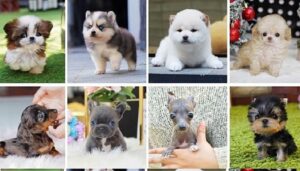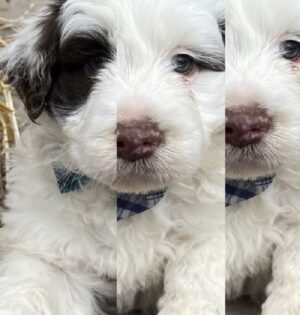Description
The Doberman Pinscher, often referred to as simply Doberman, is a remarkable breed known for its sleek and powerful appearance. Originally developed in Germany by a tax collector named Karl Friedrich Louis Dobermann, these dogs were specifically bred to be versatile and efficient working dogs. With their distinctive appearance, high intelligence, and unwavering loyalty, Doberman Pinschers have become popular companions, guard dogs, and working dogs around the world.
We will delve into the fascinating history, physical characteristics, temperament, training needs, health considerations, and suitability as family pets of the Doberman Pinscher breed. Whether you are considering adding a Doberman Pinscher to your family or simply want to learn more about this impressive breed, this article will provide you with valuable insights and information.
1. Introduction to Doberman Pinscher breed
1.1 Background of Doberman Pinschers
The Doberman Pinscher is a breed of dog that has gained a reputation for being both fearless and loyal. Originally bred in Germany by a man named Karl Friedrich Louis Dobermann (hence the name), these dogs were meant to be the perfect combination of strength, speed, and agility.
1.2 Purpose and original role of the breed
Doberman Pinschers were specifically bred as working dogs. They were originally used for tasks such as guarding and protecting their owners, as well as for serving in the military or as police dogs. Their strong protective instincts and sharp intelligence made them ideal for these roles.
2. History and origin of Doberman Pinschers
2.1 Karl Friedrich Louis Dobermann: The breed’s creator
Karl Friedrich Louis Dobermann, a tax collector from Germany, created the Doberman Pinscher breed in the late 19th century. He wanted to develop a dog that would accompany him during his daily collections and protect him from any potential danger. It was his vision and determination that led to the creation of this remarkable breed.
2.2 Influences and breeds in Doberman Pinscher’s ancestry
In order to achieve his desired characteristics, Dobermann selectively bred various dog breeds. Some of the breeds believed to be in the ancestry of the Doberman Pinscher include the Rottweiler, Weimaraner, German Pinscher, and Greyhound. These combinations resulted in a dog with exceptional qualities and a distinctive appearance.
3. Physical characteristics and appearance
3.1 Body structure and size
Doberman Pinschers are well-muscled dogs with a sleek and athletic build. They have a medium to large size, standing at around 24 to 28 inches (61 to 71 cm) tall at the shoulder and weighing between 60 to 100 pounds (27 to 45 kg). Their physique allows them to be agile and quick on their feet.
3.2 Coat colors and patterns
One of the most recognizable features of the Doberman Pinscher is its coat. They typically have short, smooth hair that comes in various colors, including black, red, blue, and fawn. The coat can also have markings like rust or tan, which often appear on the muzzle, chest, and legs.
3.3 Distinctive physical features of Doberman Pinschers
Doberman Pinschers have a distinct appearance that sets them apart from other breeds. Their heads are long and wedge-shaped, with a strong and noble expression. They have a sleek neck, a deep chest, and a well-muscled body. Their ears are usually cropped to make them stand erect, although many countries have banned this practice.
4. Temperament and personality traits
4.1 Alertness and protective instincts
Doberman Pinschers are highly alert dogs and have a natural instinct to protect their family and territory. They are known for being watchful and will quickly react to anything they perceive as a potential threat. Their protective nature makes them excellent guard dogs or companions for those seeking a sense of security.
4.2 Intelligence and trainability
Intelligence is one of the Doberman Pinscher’s greatest strengths. They are quick learners and highly trainable, which makes them suitable for various jobs and activities. With consistent and positive training methods, they can excel in obedience, agility, and other dog sports.
4.3 Loyalty and affection towards family
Doberman Pinschers are fiercely loyal and form strong bonds with their families. They are known to be affectionate and, despite their imposing appearance, often seek out physical contact and love being part of their human pack. Their loyalty and devotion make them wonderful companions for those who value a close and loving relationship with their pets.
5. Training and exercise needs
5.1 Importance of early socialization and obedience training
When it comes to Doberman Pinschers, socialization and obedience training should be right at the top of your to-do list. These dogs are incredibly smart and eager to please, but they can also be a bit stubborn if not properly trained from a young age. Early socialization helps them develop into well-rounded and confident dogs who can handle different people, animals, and environments with ease. Obedience training ensures that you have control over your Doberman and helps prevent any behavioral issues from cropping up later on.
5.2 Mental and physical exercise requirements
Dobermans are like the Energizer Bunny on steroids. They have an abundance of energy that needs to be channeled in the right direction. Mental exercise, such as puzzle toys or training sessions, helps keep their sharp minds engaged. Physical exercise is equally important, and a daily walk or run can help keep them happy and prevent any destructive behaviors that may arise from pent-up energy. Don’t be surprised if your Doberman wants to go on adventures with you—they love being active companions!
5.3 Special considerations for training Doberman Pinschers
Doberman Pinschers are intelligent and sensitive dogs that require firm but gentle training methods. Harsh punishments or heavy-handed approaches will only backfire with these sensitive souls. Positive reinforcement, using treats and praise, works wonders for motivating and shaping their behavior. Consistency is also key—you need to be clear and consistent with your commands to help your Doberman understand what you want from them. Oh, and be prepared to have some patience in your training sessions. Dobermans can be a little cheeky and may test your limits!
6. Health considerations and common medical issues
6.1 Genetic health conditions associated with the breed
While Dobermans are generally healthy dogs, there are a few genetic health conditions associated with the breed. They can be prone to conditions such as hip dysplasia, dilated cardiomyopathy, and von Willebrand’s disease. It’s important to work with a reputable breeder who conducts health screenings on their breeding stock to minimize the risk of these conditions being passed down.
6.2 Recommended health screenings and preventive care
To ensure your Doberman’s health and well-being, regular veterinary check-ups are a must. You should also consider participating in health screenings specific to the breed, such as cardiac evaluations, hip and elbow evaluations, and ophthalmologist evaluations. Preventive care, including vaccinations, flea and tick control, and dental hygiene, will help keep your Doberman in tip-top shape.
6.3 Common health issues to watch for in Doberman Pinschers
While it’s important not to be overly paranoid, there are a few health issues that Doberman owners should keep an eye out for. Some common issues include bloat (gastric dilation-volvulus), hypothyroidism, and skin conditions. Being aware of the symptoms and seeking prompt veterinary care can make a big difference in managing and treating these issues.
7. Doberman Pinschers as family pets
7.1 Compatibility with children and other pets
Dobermans can be fantastic family pets and get along well with children when properly introduced and supervised. However, due to their size and energy level, it’s important to teach children how to interact respectfully with the dog and never leave them together unsupervised. With proper socialization, Dobermans can also get along with other pets in the household, though individual personalities can vary.
7.2 Exercise and stimulation for a well-adjusted Doberman Pinscher
To keep a Doberman Pinscher happy and well-adjusted, exercise and mental stimulation are essential. They thrive in environments where they have plenty of opportunities to run, play, and explore. Daily walks, jogging, playtime in a securely fenced yard, and brain-teasing toys will help keep their active minds and bodies satisfied.
7.3 Responsible ownership and meeting their needs
Owning a Doberman Pinscher means taking on the responsibility of meeting their specific needs. This includes providing them with proper training, regular exercise, and mental stimulation. They are also social creatures who crave companionship, so be prepared to spend quality time with your furry friend. Additionally, investing in proper nutrition, healthcare, and grooming are all part of being a responsible Doberman owner. It’s a commitment, but one that comes with immeasurable love and companionship in return.
8. Conclusion and final thoughts about the breed
Doberman Pinschers are an extraordinary breed that offers a unique blend of athleticism, loyalty, and intelligence. While they require dedicated training, exercise, and socialization, the rewards of having a well-adjusted and loving Doberman by your side are immeasurable. Their protective nature and devotion to their family make them excellent companions and guardians. So, if you’re ready to welcome a lively and spirited addition into your life, a Doberman Pinscher might just be the perfect fit for you.
8. Conclusion and final thoughts about the breed
The Doberman Pinscher is a breed that encompasses both elegance and strength, making it a beloved companion and working dog for many. With its rich history, distinct physical attributes, and loyal temperament, the Doberman Pinscher has left an indelible mark on the dog world. While they require dedicated training and exercise, their unwavering loyalty and affection towards their families make them incredibly rewarding pets. However, it is important to note that responsible ownership, socialization, and proper healthcare are essential to ensure their overall well-being. If you are prepared to invest time and effort into training and caring for a Doberman Pinscher, you will be rewarded with a devoted and loving companion that will bring joy to your life for years to come.
FAQS
1. Are Doberman Pinschers aggressive?
Doberman Pinschers have a protective nature and a strong instinct to guard their family and territory. While they can be wary of strangers, aggression is not a inherent trait in the breed. Early socialization, proper training, and responsible ownership are key to ensuring a well-behaved and non-aggressive Doberman Pinscher.
2. Are Doberman Pinschers good with children?
When properly trained and socialized, Doberman Pinschers can be excellent companions for children. They are known for their loyalty and protective instincts, which can make them great family dogs. However, it is important to supervise interactions between young children and dogs, and teach children how to properly interact with and respect the dog.
3. Do Doberman Pinschers require a lot of exercise?
Yes, Doberman Pinschers are an active breed that requires regular exercise to keep them physically and mentally stimulated. They thrive on activities such as daily walks, playtime, and engaging in interactive games. Adequate exercise helps prevent behavioral issues and promotes a healthy and well-balanced Doberman Pinscher.
4. What are the common health issues in Doberman Pinschers?
Like many purebred dogs, Doberman Pinschers are prone to certain health conditions. Some of the common health issues include dilated cardiomyopathy, hip dysplasia, von Willebrand’s disease, and hypothyroidism. Regular vet check-ups, a balanced diet, and appropriate exercise can help minimize the risk of these health concerns. It is essential to work with a reputable breeder who conducts health screenings to reduce the chances of inheriting genetic disorders.
https://en.wikipedia.org/wiki/Puppy
https://en.wikipedia.org/wiki/Dog
https://en.wikipedia.org/wiki/Dog_breed
https://dogs.ie/
https://www.nextdaypets.com/directory/dogs/sale/
https://www.lancasterpuppies.com/
https://www.puppies.co.uk/
https://www.europuppy.com/
https://www.pets4homes.co.uk/sale/puppies/
https://www.puppyspot.com/puppies-for-sale
https://www.pups4sale.com.au/
https://petsforhomes.com.au/puppies-dogs-for-sale/
https://puppies.com/
https://www.freeads.co.uk/uk/buy-sell/pets/dogs/
https://www.gumtree.com/pets/pets-for-sale/dogs/uk/srpsearch+puppies
https://www.preloved.co.uk/classifieds/pets/dogs
https://www.marshallspetzone.com/196-pups-and-kittens
https://www.ukpets.com/dogs-for-sale
https://www.petfinder.com/dogs-and-puppies/adoption/finding-a-dog/puppies-for-sale/
https://marketplace.akc.org/puppies
https://waratahpuppies.com.au/puppies-and-dogs-for-sale/
https://petclassifieds.com/ad_category/dogs/
https://puppyfinder.com/
https://www.petmd.com/dog/general-health/teacup-dogs-puppies
https://www.thesprucepets.com/cute-teacup-dog-breeds-4587847
https://www.dailypaws.com/living-with-pets/pet-compatibility/cutest-puppies
https://www.goodhousekeeping.com/life/pets/g4531/cutest-dog-breeds/
https://www.canadapups.com/
https://www.ckc.ca/Choosing-a-Dog/PuppyList/Default.aspx
https://getapuppy.ca/
https://www.kijiji.ca/b-dogs-puppies/canada/c126l0




